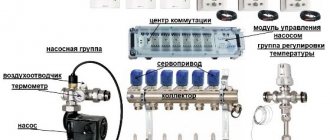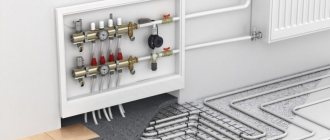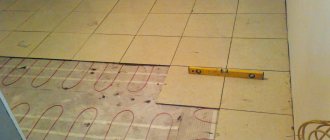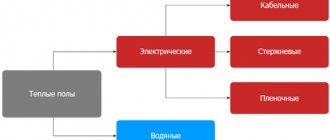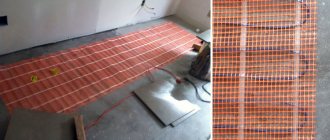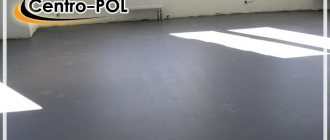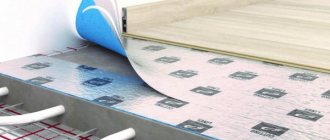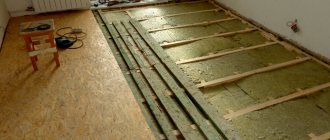Home » Equipment » Warm floor
Film-based warm floors are a good option for installation anywhere. IR heating is used in living rooms, industrial buildings, showers, and children's rooms. Due to its versatility and ease of installation, it is widely used in the building materials market.
It is easy to install and dismantle without professional skills. The principle of operation is that the graphite film, when interacting with electricity, heats up, emitting infrared warm rays.
This method does not require additional devices that accumulate heat. The storage is any covering, for example, linoleum or laminate.
Positive and negative aspects of film heated floors
Advantages of a film heating system:
- affordable price;
- a small set of elements: connecting wires, regulator, film coating;
- you can connect the system without the help of a professional;
- infrared heated floors can warm up a room without additional heaters;
But film heated floors also have negative sides:
- high energy consumption;
- network dependence;
- cools quickly;
Despite the disadvantages, this coating is popular with many people. The dimensions of the film are easy to adjust, which allows you to easily install it in rooms of any size.
Finish coatings for film heated floors
You can use carpet, linoleum and other soft materials as a finishing coating. The main thing to consider is that the film underneath is easy to damage.
Also keep in mind that cork flooring is a poor conductor of heat. In this regard, laying a heated film floor under this coating is impractical, but possible.
If there is a need to lay heating film under soft coverings, do it in places that will not be subject to heavy loads and damage (wardrobe, armchair, sofa, sectional, etc.).
Ceramic tiles are not very suitable for such a floor. Tile adhesive does not adhere well to film and you will have to use reinforced mesh to hold the adhesive. For tiles it is better to use an electric mat.
The ideal finishing floor covering for a warm film floor is laminate parquet boards.
Quick installation and the absence of specific construction and finishing work, ideal for those who want to install an electric heated floor with their own hands.
Preparation stage
Before purchasing material, you need to decide on the area that needs to be covered. Draw a layout of the room, taking into account the locations of bulky items such as appliances, shelves, cabinets, beds, etc. The film does not fit under them.
Also make a retreat of 15-20 centimeters from the walls and the listed heavy objects. Measure the resulting area and put it on the diagram; it will be needed both when purchasing the required amount of material and when installing it.
Before installing a warm film floor, you need to decide on the location of the wires and the thermostat. It is best to bring them to the wall in a free place. Then we proceed to thoroughly clean the surface.
We recommend: Features of the “combined heating: warm floor and radiators” system
It should be free of debris, dust, dirt, protruding screws and nail heads. At the joints of boards or concrete slabs, the slightest differences are excluded; if there are any, the surface will have to be additionally leveled.
Technical characteristics of heating film
Before purchasing a film floor, it is recommended to carefully study the models offered on the market in order to choose the best option in terms of quality and cost. To do this, you need to understand the differences and technical parameters of the different options.
When purchasing thermal film, it is advisable to pay attention to the following characteristics:
- power - always indicated per linear meter. Generally, 44-68 W is a suitable value;
- melting temperature - 130 degrees is indicated, but during operation it should not rise above 55 degrees Celsius;
- percentage of IR radiation in the total frequency spectrum – a value above 95% is recommended;
- material thickness – the most common thickness is 0.4 mm;
- the length and width of the film sheet is in most cases 8 x 0.5 m. Determined based on the area of the room.
Installation of film heated floors under laminate
Infrared flooring is constructed in layers that must be laid in the appropriate order. To do this, consider the step-by-step instructions:
- prepare the base. Under no circumstances should laminate be placed on an unprepared surface. Irregularities must first be removed. For this task, leveling mass is used. It is applied to the surface and left to dry for a day;
- laying a heat-insulating layer. Using a vacuum cleaner, carefully remove dirt, dust, and construction debris. Then we lay a material on the base that will prevent heat loss. It is better to use the insulation recommended by the film covering manufacturer. We attach the heat-insulating material with adhesive tape to avoid displacement during work. Don't forget about safety: do not use aluminum foil as a reflective coating. This can lead to accidents and system short-circuits. The underlying layer should not conduct electric current;
- lay out the film. Next, using the room diagram, we proceed to laying the heating film. We roll out the strips and cut them in accordance with the established sizes along special marking lines. Copper bars carrying current are laid down with a shiny surface. We connect the strips with heat-resistant tape. Then we determine the connection points between the busbars and the cable. Those that are not involved are insulated with bitumen tape;
- installation of a temperature sensor. To prevent the system element from overheating, it is installed in the coldest place of the room in the center of the strip at the same distance from both edges. The sensor is placed at a distance of at least 500 mm from the wall. Do not extend the cable if it is not long enough to connect to the regulator. If this happens, the device should be replaced. If the cable length is optimal, we proceed with installation. In the substrate we make a recess for the sensor body and a channel for the wire. We place the element on a carbon heater, secure it with bitumen tape, and pull the wire to the temperature regulator. Roll out the film and attach it to the backing;
- terminal installation. In places where equipment is connected to the circuit, we install special fastenings - terminals. We insert the upper part of the terminal into the contact section of the film coating, and remove the lower part under it. Carefully press the element with pliers - this will ensure contact with the tire;
- network connection. It is better to place all wires on one side of the canvas for ease of connection. We strip the ends of the wires by 1 cm from the insulating layer and insert them into the terminal. Press tightly with pliers. Wrap it thoroughly with electrical tape. As a result, we get a shell that will prevent short circuits in the system;
- connecting a temperature controller. We connect the cables so that they are connected to one point - to the connection point of the thermostat. It interacts with several areas of the film coating, so we use only professional terminal connections without improvised twists. There are special connectors for the wires; we connect each cable into them and return the thermostat to its place;
- test run. If everything is secured correctly, there are no exposed wires or terminals anywhere, we start the system. If the system does not start, then turn it off and eliminate the shortcomings;
- We install the floor covering. To neutralize moisture, we place insulation on the heating film. We divide the selected material into pieces of the required sizes and cover the canvas with small overlaps, then glue it with adhesive tape. After the above steps, we proceed to the laminate. It is laid in accordance with the instructions that come with each unit of product. Be careful, the IR heating floor is very fragile and can be easily damaged.
We recommend: How to lay a heated floor on the ground?
The distance between adjacent films should be at least 5-7 mm. Adjacent films should not touch or overlap each other. To avoid shifting of the film, it is necessary to secure it with double-sided adhesive tape.
Preparing heating elements for installation
First, according to a pre-drawn up scheme, film segments are prepared, but always taking into account the fact that the laying will be done in such a way that they do not overlap each other and do not touch. The manufacturer has indicated the places where the film should be cut, but if necessary, it can be cut in any other place, but only strictly between the heating strips. Afterwards, you should insulate the ends of the cut strips and for this you can use special electrical tape or adhesive tape:
- if the cut of the film coincides with the factory cut, then only the plates need insulation;
- when a cut is made between the heating strips, the entire width of the edge of the film is subject to insulation.
[rek_custom1]
Installation of film heated floors under linoleum
For linoleum, you need to perform almost the same steps, including careful preparation of the base. Polyethylene is used to insulate moisture onto the heating coating. It is laid out as follows. The sheets are laid with an overlap of 15-20 cm, secured with adhesive tape.
It is important not to damage the heating surface. You need to move along it very carefully.
Now you need to cover the surface with fiberboard sheets. This will give protection to the infrared floor and create an excellent “foundation” for the linoleum. Linoleum sheets must be rolled out and heated at a temperature of 27-28 degrees during the day, this will facilitate subsequent installation.
After warming up, the linoleum is attached to the base using adhesives; the glue will help to evenly distribute the incoming heat. But if dismantling is possible, then it is better to use a plinth.
What is an electric heated film floor?
The floor is called film because it is not the cable that heats the surface, but a special film. Its thickness is only about half a millimeter. It consists of copper wires and carbon semiconductors.
The film does not emit an electromagnetic field, as it heats due to infrared waves, which have a beneficial effect on your health. It heats only those materials that stand in their path, and almost does not heat the air. For this specific heating property it is called infrared film heated floor.
The temperature sensor can be placed both on the film and under it (along the groove). Which method is preferable for specific films, check with the seller or manufacturer.
General recommendations
Infrared flooring is ideally combined with laminate, linoleum and other floor coverings. Installation of film heated floors is quite simple to perform.
If desired, it can be done in a day, but you must follow the installation rules, their sequence and be careful with the IR coating. Strict adherence to the recommendations will allow the floor to function for a long time without malfunctions.
It is worth noting that linoleum is preferred by those who choose simplicity, quality and affordable prices; this is a good budget option for flooring.
Laminate flooring is popular due to the fact that the correct combination with a film floor will give active heat release with rapid heating of the room, and the original design will satisfy the aesthetic desires of any person.
- Related Posts
- Features of heated floors made of metal-plastic pipes
- How to lay a heated floor in a bathroom under tiles?
- What characteristics does Shtein underfloor heating have?
- What are the characteristics of Rehau pipes for underfloor heating?
- What characteristics does a two-core heated floor have?
- How to lay polystyrene foam for heated floors?
Types of material
Two types of material are produced: with a bimetallic and carbon heater. The first one is cheaper and is made on the basis of polyurethane polymer. It must not be connected to the ground wire. Therefore, they are connected via RCBO or RCD. This is a mandatory condition that complicates the installation of the system. Another feature of the bimetal version: installation of such an electric heated floor under the tile is prohibited. Models with a carbon element are more expensive, but there are no restrictions on their use and no additional difficulties during installation.
Rules for placing heating fabric
Heating of this type can be either primary or additional. In the first case, it is necessary to put the film on 70% of the area, in the second, everything depends on the quantity and power of the main heat sources. However, in any option, important recommendations should be taken into account.
It is optimal to lay the heating sheet at a distance of 0.5-0.6 m from each wall. This will allow you to painlessly rearrange the furniture in the future, if necessary.
Calculation of materials and preparation of tools
Tools required for installation:
To install a heated floor, you will need to prepare the following materials:
It is also necessary to prepare finishing materials used as flooring. If the size of the film strips is not suitable for installation in the room, they can be cut.
However, this procedure must be carried out as carefully as possible, after making sure that the manufacturer of a particular model allows this.
It should be noted: to connect the cable contacts, it is important to use only the terminals that come with the kit. It is prohibited to use a tin connection or solder any section to the strip structure of a heated floor.
When soldering, the busbar that conducts electricity heats up significantly, resulting in an increased risk of damage to the contact point of the wire. This can in many cases cause a breakdown of the entire communication. Installation and connection should be made using crimp connection elements.
Which laminate to choose
The choice of coating model is important for the normal functioning of a heated floor under a laminate. Parquet that is not suitable for the type will be deformed, poorly transmit heat and emit formaldehyde above the permissible norm.
Laminate flooring with heated film must meet the following requirements:
- have a locking connection, it is not recommended to use glue for installing slabs, it creates a rigid seam that breaks when there are temperature changes;
- have high heat-conducting properties, for infrared heated floors the coefficient is 0.05-0.10 m2 x °K/W;
- the optimal thickness of the slabs is 8 - 9 mm; if they are thinner, the locking joint is destroyed when the temperature changes, and thick ones do not transmit heat well;
- do not emit formaldehyde when heated above the permissible limit; floor coverings of class EO and K1 are suitable;
- be wear-resistant, not lower than class 3, the higher this indicator, the higher the strength of the floor.
Based on these requirements, it is necessary to buy laminate flooring. In addition, there must be a special icon on the packaging or in the instructions for the product; it indicates the ability to combine this laminate with heating elements.
Features of infrared film
It is made from durable polymer. The production technology involves applying strips of carbon-graphite paste to a plastic sheet. They are covered with another layer of plastic and laminated. To connect semiconductors, silver-coated copper bars are used. Carbon paste acts as a heating element that converts electrical energy into heat.
Copper busbars form a heating circuit through which heat is evenly distributed. The degree of heating is controlled by a thermostat connected to a temperature sensor. When the temperature goes beyond the preset values, the system turns off or turns on. The laminating coating on the panel is a protective heat-resistant and electrically insulating layer with a melting point of 210 °C.
The material is produced in strips 600-5,000 cm long. It depends on the model and brand. In any case, the maximum permissible length of the web in the assembly is indicated on the packaging. Usually it does not exceed 800 cm. For long rooms, it is recommended to assemble two or three strips, and connect each one to a thermostat. Otherwise, the equipment will not work correctly. Standard blade width is 500-1000 mm.
For residential premises, a material with a width of 500-600 mm is usually chosen. For industrial and office premises, as well as for baths, wider panels are purchased. The system is powered from a single-phase electrical network of 220 V. Maximum heating occurs within two to three minutes after power is applied. Overheating and melting of the laminating layer is unlikely, given the high values of its melting point. If installation is carried out correctly, heating to critical temperatures never occurs.
Principle of operation
The operating principle of IR film is simple. The current is applied to the metal bars, which heat up and heat up the carbon fiber strips. They, in turn, when heated, begin to generate infrared waves in a range that is safe for living organisms. The radiation is captured by any opaque objects, accumulated by them, and then released into the air. This way the room warms up quickly and efficiently.
